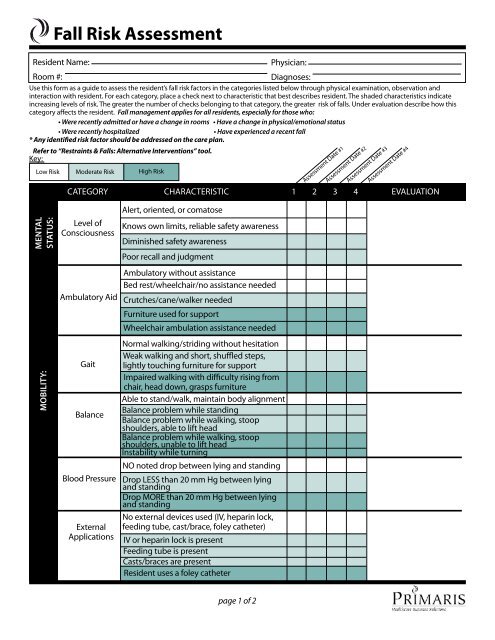Facts About Dementia Fall Risk Revealed
The Buzz on Dementia Fall Risk
Table of ContentsGetting My Dementia Fall Risk To WorkOur Dementia Fall Risk Ideas4 Simple Techniques For Dementia Fall RiskHow Dementia Fall Risk can Save You Time, Stress, and Money.
A loss threat analysis checks to see just how likely it is that you will drop. The analysis typically consists of: This includes a series of inquiries concerning your overall health and wellness and if you have actually had previous falls or problems with balance, standing, and/or strolling.Treatments are referrals that might decrease your risk of falling. STEADI includes three steps: you for your danger of dropping for your danger factors that can be boosted to try to stop drops (for instance, equilibrium troubles, damaged vision) to lower your risk of dropping by utilizing effective approaches (for example, providing education and sources), you may be asked numerous inquiries including: Have you fallen in the previous year? Are you stressed concerning dropping?
After that you'll take a seat once more. Your supplier will certainly examine for how long it takes you to do this. If it takes you 12 secs or more, it might mean you go to greater danger for an autumn. This test checks toughness and balance. You'll sit in a chair with your arms went across over your chest.
The positions will obtain more challenging as you go. Stand with your feet side-by-side. Relocate one foot midway ahead, so the instep is touching the big toe of your other foot. Move one foot totally in front of the various other, so the toes are touching the heel of your other foot.
The 7-Minute Rule for Dementia Fall Risk
The majority of falls occur as a result of multiple contributing factors; as a result, handling the threat of dropping begins with identifying the elements that add to fall risk - Dementia Fall Risk. A few of one of the most pertinent risk variables include: History of previous fallsChronic clinical conditionsAcute illnessImpaired gait and equilibrium, lower extremity weaknessCognitive impairmentChanges in visionCertain risky drugs and polypharmacyEnvironmental factors can also raise the threat for drops, consisting of: Poor lightingUneven or damaged flooringWet or slippery floorsMissing or damaged hand rails and get hold of barsDamaged or poorly equipped equipment, such as beds, wheelchairs, or walkersImproper use of assistive devicesInadequate supervision of the people living in the NF, consisting of those that show hostile behaviorsA effective autumn danger management program calls for a thorough clinical analysis, with input from all participants of the interdisciplinary group

The treatment strategy need to likewise consist of interventions that are system-based, such as those that advertise a secure setting (suitable illumination, handrails, grab bars, and so on). The effectiveness of the interventions need to be assessed occasionally, and the care plan changed as needed to Homepage show changes in the fall danger evaluation. Carrying out a fall threat monitoring system utilizing evidence-based ideal technique can minimize the frequency of drops in the NF, while limiting the capacity for fall-related injuries.
The Definitive Guide to Dementia Fall Risk
The AGS/BGS guideline advises evaluating all adults matured 65 years and older for fall threat annually. This testing is composed of asking individuals whether they have actually dropped 2 or even more times in the previous year or sought clinical interest for a loss, or, if they have actually not fallen, whether they really feel unsteady when strolling.
Individuals that have fallen when without injury ought to have their balance and gait assessed; those with gait or equilibrium abnormalities should get additional evaluation. A background of 1 autumn without injury and without gait or balance problems does not necessitate more assessment beyond ongoing yearly fall risk screening. Dementia Fall Risk. An autumn threat evaluation is needed as component of the Welcome to Medicare examination

The Of Dementia Fall Risk
Recording a drops background is just one of the quality indicators for loss avoidance and administration. An essential component of threat assessment is a medication testimonial. A number of classes of medications increase fall danger (Table 2). Psychoactive medications in particular are independent forecasters of drops. These drugs have a tendency to be sedating, alter the sensorium, and harm balance and gait.
Postural hypotension can commonly be relieved by minimizing the dose of blood pressurelowering medications you could check here and/or quiting drugs that have orthostatic hypotension as a negative effects. Use above-the-knee support hose and resting with the head of the bed boosted may additionally reduce postural reductions in high blood pressure. The recommended aspects of a fall-focused physical exam are displayed in Box 1.

A TUG time better than or equivalent to 12 secs recommends high autumn threat. Being incapable to stand up from a chair of knee elevation without making use of one's arms indicates increased loss danger.